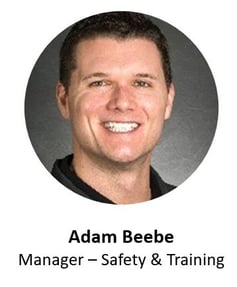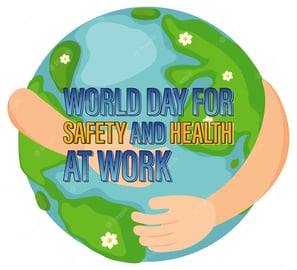Every year on April 28th, the world observes the World Day for Health and Safety at Work. This day was established by International Labor Organization to raise awareness about the importance of providing a safe and healthy workplace for employees across the world! This day is an opportunity to reflect on the challenges that workers face in their jobs and to overview the necessity for improvements in workplace safety and health.
We spoke with UGI Energy Service's Safety & Training Manager, Adam Beebe to learn more about UGIES' focus on safety.
What is the role of a Safety leader at UGI Energy Services?

It is important to note that safety leaders do not only reside in the safety department. Safety leadership can come from anyone in a position of influence that chooses to promote and drive safety success. Some responsibilities of this role include making sure everyone understands expectations, coach deficiencies, make corrections where necessary, champion safety initiatives, and encourage everyone to provide feedback so that improvement can take place.
Who comprises the UGI Energy Services Safety Department?
The UGIES Safety department comprises five-team members, three of which are field safety specialists, all assigned to different regions of the Energy Services footprint. These “boots on the ground” safety professionals all handle the daily safety support functions of their assigned areas. Patrick Lawrence CSP - Field Safety Specialist II, is the longest standing member of the department and is assigned to the LNG and LPG assets that are in and around the Central Pennsylvania region. Marc Scott - Field Safety Specialist II, is positioned to support the Appalachia Pipeline Operations Group, and our newest team member, Alex Preston - Field Safety Specialist, based in Mansfield, PA, is assigned to support the Northern pipeline assets.
Melissa Masciotti - Safety and Training Coordinator, is an office-based employee tasked with coordinating the employee operating qualifications program and safety training schedule. Adam Beebe CSP - Manager of Safety and Training, another newcomer from UGI Utilities, is tasked with managing the department, as well as the continuous improvement of both safety and training efforts at UGIES.
What record of safety has our company maintained over the past several years and in the most recent year?
Although these figures do not give a completely accurate representation of the ongoing safety performance of the organization, UGIES has maintained an impressive OSHA injury rate and motor vehicle incident rate over the past few years.
The OSHA injury rate has seen a reduction over the past two fiscal years, from 0.74 in FY21 to 0.53 in FY22. The OSHA injury rate is calculated by multiplying the company’s total number of injuries by 200,000 before dividing by the total number of hours worked across the company. This calculation was developed by OSHA to benchmark an organization’s injury metrics against their industry peers.
Regarding our motor vehicle incident rate, last year we saw a notable reduction in the FY21 rate, from 2.72 -> 1.71 in FY22.
How does the Department go about fostering and encouraging a safe work environment throughout UGI Energy Services?
It starts with educating employees on the expectations. If employees aren’t aware of how work is expected to be performed and the associated risks, how can we expect them to safely adhere to those guidelines? Once the expectations are known and employees are qualified to do the work, regularly monitoring and observing work, and inspecting facilities help verify those expectations are being followed through on. When there are deviations away from expectations, this is where safety leaders need to step in and seek to understand why this is. When we capture this information, it is either up to us to modify the expectations or coach and correct the shortcomings. It is important to remember that our policies and procedures may seem to be flawless on paper but may be impractical once the controls are implemented. We need to continually request feedback to continually improve.
We can only improve our safety success if people are openly sharing their pain points and concerns. This can be tricky if employees lack the confidence or trust to openly share these conditions with us.
To what can UGIES attribute such an excellent safety record?
The front-line workers and their immediate supervisors deserve the credit for our impressive safety record. It is their willingness to follow guidance and share their thoughts towards safety that continues to improve our safety performance. Our employees have established a culture at UGIES of taking safety seriously and holding themselves and each other accountable to ensure everyone goes home every day in the same condition that they came into work in the morning.
What safety goals do we have as a company going forward?
Statistically speaking, UGI Energy Services strives to improve the company safety metrics by 5% each year. Of course, our overall safety goal is the elimination of all injuries and motor vehicle incidents. It is important to understand that this is an aggressive goal when we consider the environmental conditions and labor-intensive work our employees regularly perform.
As a department, our goal is to continue to build rapport with the people performing the work. These people are the subject matter experts that can provide us with the truly valuable information that we can use to continually bolster our defenses (controls) and recoverability against hazard and undesirable outcomes. In addition to improving the controls, we are working to advance the safety trainings and operator qualifications to increase our worker’s capabilities to deal with those identified hazards and their ability to properly respond when faced with risky conditions.
How can employees learn more about contributing to a safe workplace?
Whatever their position here at UGIES, we encourage our employees to reach out to the Safety department if they are ever interested in more safety-related information. Internally, employees can view many of our documents within the safety tab of the company’s SharePoint page. In addition, our Marlin TV systems in the office are set up to provide up to date UGIES safety metrics and information.
Externally, there are countless resources for work and home-related safety information and education. A good place to start is the National Safety Council website, which offers plenty of information that can be utilized whether at work, or play.
If you are interested in learning more about compliance law, check out the OSHA.Gov website. Although much of the information is dry, they have worked hard in recent years to increase the amount of safety information for the general public. Lastly, we would recommend you check out the American Society of Safety Professionals website (ASSP). Here you can find many resources and even digital copies of their monthly magazine, the Professional Safety Journal.
What is one of the more notable safety accomplishments at UGI Energy Services in recent years?
UGIES went over 18 months in 2021 and 2022 with Zero accountable motor vehicle incidents or recordable injuries. This is an impressive accomplishment, given the number of hours worked and miles driven during that time!
How can employees continue safety practices outside of work?
Safety starts with recognizing the foreseeable hazards related to your activity and the hazards in your environment. Once hazards are recognized, develop a plan to eliminate or reduce the likelihood of contact with them. If you cannot eliminate those hazards, protect yourself, just in case!
For example, before cutting your lawn, consider what hazards are around your property, as well as what hazards are created when operating the mower. This may include walking your property to identify anything that could be considered a hazard like rocks, pests, or rough and uneven terrain. Once you have identified the hazards and have developed a plan to avoid those, focus on what sort of protection you may need for the hazards you could not eliminate, such as ear plugs, safety glasses, and sturdy footwear with ankle protection.
Lastly, we would not hand an employee a piece of equipment and expect them to safely operate that equipment if they had not yet been properly trained. This mindset should exist at home! Avoid performing a task without first familiarizing yourself and other involved parties with the equipment. Review the equipment manual or watch a demonstration video and practice performing the work while the stakes are low.
We sat down with Adam Beebe, Manager of Safety and Training to learn more about himself and a bit about his philosophy towards workplace safety and health. Adam Beebe was a member of the UGI Utilities safety department for four years before transitioning into the Manager of Safety and Training position at UGI Energy Services. Before joining the UGI Family, Adam, a Certified Safety Professional (CSP) and career safety practitioner was mostly unfamiliar with the natural gas industry. To that point in his career, Adam had worked for various high-voltage utility contractors contributing to projects as a field safety resource. Adam feels that his many years spent as a front-line safety leaders has prepared him well for his current opportunity. Adam said that spending countless hours interacting with front line workers on jobsites, as well as his interest in human and organization performance (HOP) have heavily influenced his current views towards safety.
Adam said that human performance refers to the methods in which people interact with their environment at work. He went on to explain: “Think about the effects that processes, tools, equipment, environments, and organizational culture have on a person’s performance. Having a HOP mindset allows us to go beyond human error to see what deeper conditions may have influenced, or led to an error occurring. In addition to studying events, this mindset is especially beneficial for identifying pain points that may one day attribute to an event, meaning, we don’t have to wait for an undesirable event to occur. Instead, with this paradigm shift towards safety, organizations can drastically increase the amount of learning and improving from normal work.”
In addition to safety, Adam is also excited to lead the training program at Energy Services. He feels that the two are two-sides of the same coin, commenting that, “you can give a person the best tools, equipment, and procedures to perform their job safely, but if you don’t provide that person with the competence and confidence to perform their job, you’re not setting that person up for success.





